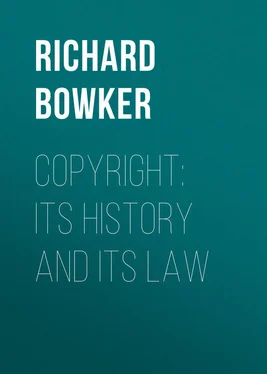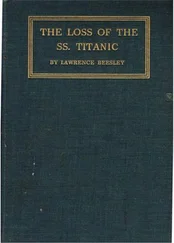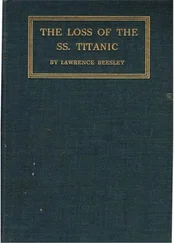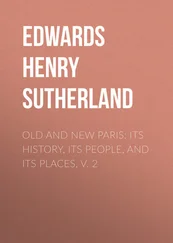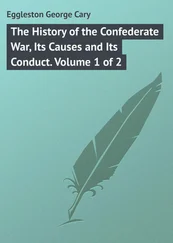Richard Bowker - Copyright - Its History and Its Law
Здесь есть возможность читать онлайн «Richard Bowker - Copyright - Its History and Its Law» — ознакомительный отрывок электронной книги совершенно бесплатно, а после прочтения отрывка купить полную версию. В некоторых случаях можно слушать аудио, скачать через торрент в формате fb2 и присутствует краткое содержание. ISBN: , Жанр: foreign_antique, foreign_prose, Историческая проза, на английском языке. Описание произведения, (предисловие) а так же отзывы посетителей доступны на портале библиотеки ЛибКат.
- Название:Copyright: Its History and Its Law
- Автор:
- Жанр:
- Год:неизвестен
- ISBN:http://www.gutenberg.org/ebooks/39502
- Рейтинг книги:3 / 5. Голосов: 1
-
Избранное:Добавить в избранное
- Отзывы:
-
Ваша оценка:
- 60
- 1
- 2
- 3
- 4
- 5
Copyright: Its History and Its Law: краткое содержание, описание и аннотация
Предлагаем к чтению аннотацию, описание, краткое содержание или предисловие (зависит от того, что написал сам автор книги «Copyright: Its History and Its Law»). Если вы не нашли необходимую информацию о книге — напишите в комментариях, мы постараемся отыскать её.
Copyright: Its History and Its Law — читать онлайн ознакомительный отрывок
Ниже представлен текст книги, разбитый по страницам. Система сохранения места последней прочитанной страницы, позволяет с удобством читать онлайн бесплатно книгу «Copyright: Its History and Its Law», без необходимости каждый раз заново искать на чём Вы остановились. Поставьте закладку, и сможете в любой момент перейти на страницу, на которой закончили чтение.
Интервал:
Закладка:
Material and immaterial property
The American code adopts into the law an important distinction as between the property in the material and the immaterial rights, hitherto somewhat uncertain, in the following provision (sec. 41): "That the copyright is distinct from the property in the material object copyrighted, and the sale, or conveyance, by gift or otherwise, of the material object shall not of itself constitute a transfer of the copyright, nor shall the assignment of the copyright constitute a transfer of the title to the material object; but nothing in this Act shall be deemed to forbid, prevent, or restrict the transfer of any copy of a copyrighted work the possession of which has been lawfully obtained."
The negative provision in this section was inserted in the new copyright law apparently to differentiate it from patent law with the intent of preventing the proprietor of a copyrighted work from controlling the conditions of sale after copies had left his possession. It is doubtful what, if any, effect this provision may have, as the phrase "lawfully obtained" would scarcely have the result of limiting and annulling contractual conditions of sale. The innocent purchase of a stolen book would not relieve the purchaser from the necessity of returning the stolen property to its proper owner, although as far as intent, knowledge, and payment are concerned, he would have "lawfully obtained" it.
Schemes not copyrightable
The scope of copyright cannot be extended to cover a business or other scheme described in a copyrighted book, as was held in 1906 in Burk v . Johnson by the Circuit Court of Appeals in denying relief under copyright protection to the originator of a mutual burial association who copyrighted the articles of association.
The new British code
The new British measure defines copyright to mean "the sole right to produce or reproduce the work or any substantial part thereof in any material form whatsoever and in any language," thus assuring rights of translation hitherto imperfect or doubtful; "to perform, or in the case of a lecture to deliver, the work or any substantial part thereof in public; if the work is unpublished, to publish the work"; and specifically includes the sole right of dramatization (from an "artistic," as well as other non-dramatic work), novelization, and reproduction by mechanical means (though with compulsory license provision as to reproduced music). A copyright may be assigned or licensed "either wholly or partially, and either generally or subject to limitations to any particular country, and either for the whole term of the copyright or for any part thereof."
"Copyright or any similar right in any literary dramatic musical or artistic work, whether published or unpublished," is expressly denied "otherwise than under and in accordance with the provisions of this Act" or other statutory enactment; and thus common law seems to be totally abrogated. Hitherto common law property in an unpublished work has been absolute and co-existed with statutory remedies up to publication, as was strongly upheld in 1908 in Mansell v . Valley Printing Co. in the English Court of Appeal. As to published works, the new code continues the settled law reiterated as late as 1910 in Monckton v . The Gramaphone Co., where Justice Joyce in the Chancery Division denied the common law claim of the author of a song printed with prohibition of mechanical production, on the ground that after publication there was no copyright except as given by statute.
Foreign statutes
The statutes of foreign countries are in general of similar scope, though with variations of extent and phraseology in the several countries. The broadest seems to be that of Siam, above cited, translating common law rights into statutory privilege, though that country also contradictorily limits copyright in books by a manufacturing clause. Spain specifically protects works produced or published by "any kind of impression or reproduction known now or subsequently invented," as elsewhere quoted. France specifically gives an author right to assign his property in whole or in part – a right which is probably included in other countries under the general construction of statutory rights in property.
International provisions
The international copyright convention, as modified at Berlin, does not define the scope of copyright, but insures for authors the enjoyment of such rights as the domestic laws accord to natives; but in its several articles it makes specific provision as to representation, translation, adaptation, mechanical reproduction, etc., as set forth in the chapter on international copyright conventions.
Common law, or a crude equivalent for it, as enforced by the courts, seems to extend copyright protection, in the absence of specific legislation, in Montenegro, Egypt and Liberia, Honduras, the Dominican Republic, and Uruguay, as formerly in Argentina.
VI
SUBJECT-MATTER OF COPYRIGHT: WHAT MAY BE COPYRIGHTED
Subject-matter in general
The subject-matter of copyright should include, in the nature of things, those products of invention, creations of the human brain, which are realized and utilized immaterially through material records, and not, as in the case of patents, materially through the material itself. Copyrightable works, in brief, are those which appeal from the imagination to the imagination, or in which intellectual labor combines immaterial product into new form. What may be copyrighted specifically and practically depends, under present conditions of law, upon the statutory provisions, national or international, of the several nations of the world.
Classification
The new American code gives the following classification of copyrightable works:
"(Sec. 5.) That the application for registration shall specify to which of the following classes the work in which copyright is claimed belongs:
"(a) Books, including composite and cyclopædic works, directories, gazetteers, and other compilations;
"(b) Periodicals, including newspapers;
"(c) Lectures, sermons, addresses, prepared for oral delivery;
"(d) Dramatic or dramatico-musical compositions;
"(e) Musical compositions;
"(f) Maps;
"(g) Works of art; models or designs for works of art;
"(h) Reproductions of a work of art;
"(i) Drawings or plastic works of a scientific or technical character;
"(j) Photographs;
"(k) Prints and pictorial illustrations:
" Provided, nevertheless , That the above specifications shall not be held to limit the subject-matter of copyright as defined in section four of this Act, nor shall any error in classification invalidate or impair the copyright protection secured under this Act."
Prints and labels excluded
Prints or labels "not connected with the fine arts," but "designed to be used for any other articles of manufacture," are subject only to registration in the Patent Office in accordance with the act of June 18, 1874.
All the writings of an author
It is enacted (sec. 4): "That the works for which copyright may be secured under this Act shall include all the writings of an author," thus linking the phraseology of the law with the provision in the Constitution of the United States in which the word "writings" is used, with the effect of construing that word by the classification above cited.
Component parts
It is also enacted (sec. 3): "That the copyright provided by this Act shall protect all the copyrightable component parts of the work copyrighted, and all matter therein in which copyright is already subsisting, but without extending the duration or scope of such copyright. The copyright upon composite works or periodicals shall give to the proprietor thereof all the rights in respect thereto which he would have if each part were individually copyrighted under this Act."
Читать дальшеИнтервал:
Закладка:
Похожие книги на «Copyright: Its History and Its Law»
Представляем Вашему вниманию похожие книги на «Copyright: Its History and Its Law» списком для выбора. Мы отобрали схожую по названию и смыслу литературу в надежде предоставить читателям больше вариантов отыскать новые, интересные, ещё непрочитанные произведения.
Обсуждение, отзывы о книге «Copyright: Its History and Its Law» и просто собственные мнения читателей. Оставьте ваши комментарии, напишите, что Вы думаете о произведении, его смысле или главных героях. Укажите что конкретно понравилось, а что нет, и почему Вы так считаете.
